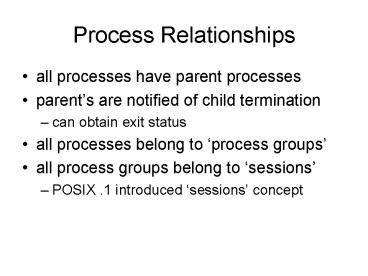Process Relationships - PowerPoint PPT Presentation
1 / 16
Title:
Process Relationships
Description:
login program takes user ID, prompts for password, and ... process group ID's are positive integers. process groups may ... process group of caller ... – PowerPoint PPT presentation
Number of Views:97
Avg rating:3.0/5.0
Title: Process Relationships
1
Process Relationships
- all processes have parent processes
- parents are notified of child termination
- can obtain exit status
- all processes belong to process groups
- all process groups belong to sessions
- POSIX .1 introduced sessions concept
2
Terminal Logins
- classic UNIX access provided by dumb terminals
- monitor, keyboard and local line or modem
connection - contemporary access uses the terminal metaphor
- pseudo-terminals provided for network access
3
4.3 BSD Terminal Logins
- terminal logins involve opening terminal or
pseudo-terminal devices and execing the login
program - login program takes user ID, prompts for
password, and then establishes parameters of the
working session - last step is for login to exec our login shell
4
SVR4 Terminal Logins
- SVR4 logins are handled as per BSD, with the
addition of ttymon logins. - ttymon logins have a different call structure,
but function as per BSD logins from the exec of
the login program forward
5
Network Logins
- network logins use the same terminal metaphor
that physical terminal logins employ - from the call to login forward, local terminal
logins and network logins are essentially similar
6
BSD and SVR4 Network Logins
- network logins take place via a TCP/IP connection
request, at which point a specific server
establishes a two-way communication and opens a
pseudo-terminal - telnet telnetd handles terminal access
- ssh sshd handles terminal access
- both BSD and SVR4 use the same basic logic for
terminal access, though the call structures vary
7
Common login Features
- all logins evaluate user data from password,
group, etc. and establish working environments - all logins complete by execing a shell process
(login shell), and finish when that shell exits
8
Process Groups
- all processes belong to a process group
- processes default to the process group of their
parent or execer - process group IDs are positive integers
- process groups may have a leader
- PGID PID for leader
- processes can join other groups in same session
- must not be group leader
9
PGID functions
- two function used to manipulate process groups
- getpgrp() fetches process group of caller
- setpgid() places a process in an existing group
or creates a new one - can be done for calling process or children
10
Sessions
- collection of one or more process groups
- processes are usually grouped via a pipeline
- created by calling setsid()
11
setsid() function
- setsid() does three things
- caller made session leader of new session
- caller made group leader of new group
- process is made to have no controlling terminal,
if one existed prior to the call - caller must not be a process group leader
12
Controlling Terminal
- each session can have only one controlling
terminal, and a terminal controls at most one
session - the session leader connected to the controlling
terminal is the controlling process - session leaders allocate controlling terminals
for their sessions via ioctl calls - process groups in a session with a controlling
terminal are either foreground or background - one foreground group
- terminal signals go to this group
- one or more background groups
13
tcgetpgrp() and tcsetpgrp() Functions
- tcgetpgrp() returns foreground group associated
with a particular file descriptor - tcsetpgrp() sets the foreground process group
- can be used by process with a controlling
terminal to change the foreground group to one
from another group within the same session
14
Job Control
- BSD feature from early 80s
- controls multiple foreground and background
processes - shells with job control can assign processes to
foreground or background - foreground processes receive terminal input,
background do not - standard terminal signals are sent to the
foreground group
15
Job Controll Shell Execution of Programs
- programs executed within job control shells are
assigned to the foreground group by default - if assigned to the background group, programs
will stop if need to read from terminal - output to terminal may be allowed or disallowed
- user will be notified at next prompt
- background process can be moved to foreground
16
Orphaned Process Groups
- a process group is orphaned when no parent
processes exist outside the group but in the
session. - terminal signals are not sent to the processes in
orphaned groups - any stopped process in an orphaned group is
automatically sent the the SIGHUP and SIGCONT
signals when the group is orphaned.































